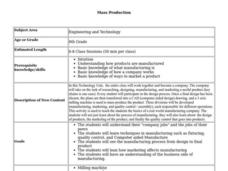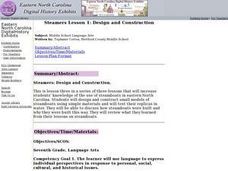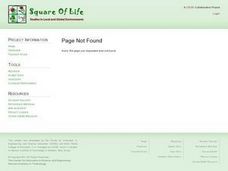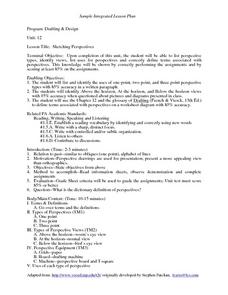Curated OER
Basic Design Elements Computer Art Project
Students use PhotoDraw software to create original drawings. Using the basic design elements, line, shape, form, texture, value, and color, students create original drawings on the computer based on drawings previously rendered by hand.
Curated OER
Basic Design Elements Computer Art Project
Students use PhotoDraw software to create original drawings. Using the basic design elements, line, shape, form, texture, value, and color, students create original drawings on the computer based on drawings previously rendered by hand.
Curated OER
Apply Technological Design and Scientific Habits of Mind
Students work together to brainstorm their obstacles in testing different scientific principles. In groups, they are given a scenerio with a specific dilemma and they use the internet to research how to solve the problem. They design a...
Curated OER
Cemetery Art And Architecture Detectives
Students investigate the architecture found in cemeteries in order to separate different time periods of distinct design. The use of examples helps them to recognize the design in correlation to its time. The instructional activity is...
Curated OER
The Sum of the Parts
Second graders observe some everyday common objects in order to attempt to learn about simple systems and how they fit together. They observe small details in order to identify the parts of a whole design.
Curated OER
Detecting Systems
Fourth graders participate in a lesson that attempts to explain how a system works. They examine the parts and how they fit together. The question of what happens to a system if a pert is missing is asked.
Curated OER
Everything Has Parts
Students investigate and explore common objects to discover and identify their parts. They also are encouraged to discuss the need for specific parts and what happens when a part is missing from the whole.
Curated OER
Design & Technology: Materials Strength
High schoolers investigate the function of a floor stretcher and some of the past designs. The goal is to improve the design durability and ease of use. Then they sketch their ideas and write a rationale for changes made to the structure.
Curated OER
Artsy Insects
Students identify and describe the elements of art and principles of design by creating several different butterfly pictures that represent color, shape, texture, pattern or symmetry.
Curated OER
Art-What's it good for?--Absolutely everything!
Students pay attention to details in houses in order to improve observation skills. The skills then are used to help create a three dimensional drawing of a house. Students also examine advertising methods.
Curated OER
Parks Design Project
Learners explore two dimensional geometric figures. They explore the relationships and measurements of geometric figures. Students apply proportion and scaling. They design a city park for learners and teenagers.
Curated OER
Building a Better Mousetrap
Eighth graders are introduced to the "Design Process" for technological development by constructing a prototype of a humane mousetrap. Students must record the steps their design groups go through while designing their prototypes and...
Curated OER
Mass Production
Sixth graders work together as a class to become a company that has the job of researching, designing, manufacturing, and marketing a useful product. Student transfer plans of final design into a CAD drawing and mass produce the...
Curated OER
Secrets of Lost Empires I-Colosseum
Sixth graders identify how to use pulleys to change the direction of force. Students develop ways to evaluate designs, noting that no one best design exists and that different tasks require different designs. Students designs will vary.
Curated OER
Playground Structure Model
Students, working in groups, design and create a model of a playground shelter, based on specific criteria. Student designs must include research and analysis into weather conditions, safety factors and the cost of the finalized project.
Curated OER
Steamers Lesson 1: Design and Construction
Students examine the use of steamboats in North Carolina. In groups, they design and contruct their own small models of steamboats using simple materials. They test their models in water and share how they were built and why. They...
Curated OER
Places and Spaces in Art
Students examine and describe the houses of Baie Saint-Paul. They name the colors used and the shapes in the roof. Using a gable roof design, they draw their own house. They discover the architectrual elements in their own community...
Curated OER
Designing Our Own Inventions
Third graders use research from a previous lesson to design their own inventions. In groups, they brainstorm a product they would like to see built and share them with the class. They must explain how each one would serve a purpose or...
Curated OER
Mini-Squares of Life
Students brainstorm to decide the best way to mark off square areas (that they will later study) that are smaller than one meter. They compare the suitability of different designs and create "mini-square markers." Finally, they test...
Curated OER
Connecting Downtown
Learners examine how engineering and design make cities more livable and efficient. They study different types of walkways including elevated and underground walks, and where and why they would be used. They design their own walkway...
Curated OER
Mobile Phone Design
Students examine their families usage of mobile phones. They work with students in different countries to design their own mobile phone. They inturn set up their own project for mobile phones.
Curated OER
Sketching Perspectives
Learners list perspective types, identify views, list uses for perspectives and correctly define terms associated with perspectives.
Curated OER
Welcome to Our Classroom!
Students observe a piece of artwork by Rafael Ferrer that surrounds an archway. They discuss the sculpture and design an archway for the classroom door.
Curated OER
Aesthetic Assessment Design
Students examine aesthetic concepts and reflect on them in their journals. They construct individual taste collages from an assortment of two and three-dimensionakl objects.

























